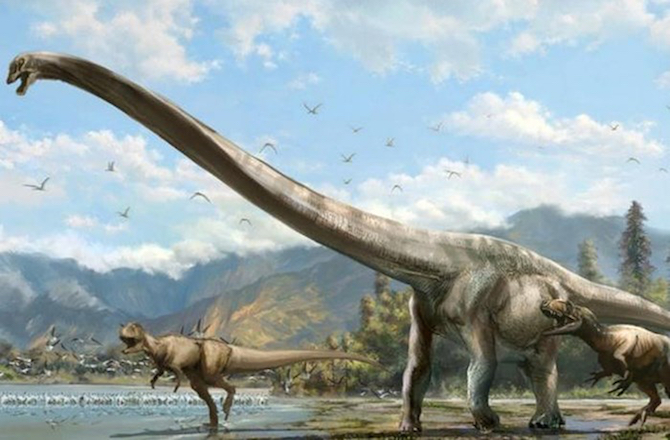- Tel: +86 813 2105845
- Fax: +86 813 2105845
- Mob: +86 13778532392
- Contact: Mr. Jacky
 info@dinosaurs-world.com
info@dinosaurs-world.com Jackydinosworld@gmail.com
Jackydinosworld@gmail.com Jackyyiming@gmail.com
Jackyyiming@gmail.com Jackyzengdinosaursworld
Jackyzengdinosaursworld
- 50-Foot-Long 'Dragon' Dinosaur Unearthed in China

An enormous 50-foot-long dinosaur named "Dragon of Qijiang" was unearthed by construction workers near Qijiang City, China.
The plant-eating dinosaur, Qijianglong guokr, had an unusual body that was half neck. It lived about 160 million years ago and is described in the latest issue of the Journal of Vertebrate Paleontology.
The construction crew that happened upon the dinosaur remarkably managed to unearth the dinosaur with its head still attached to its long, narrow neck.
"It is rare to find a head and neck of a long-necked dinosaur together because the head is so small and easily detached after the animal dies," co-author Tetsuto Miyashita said in a press release.
"Qijianglong is a cool animal," added Miyashita, who is a University of Alberta paleontologist. "If you imagine a big animal that is half neck, you can see that evolution can do quite extraordinary things."
Most sauropods (i.e. long-necked, plant-eating dinosaurs) have necks that are about one-third the length of their bodies, so "Dragon of Qijiang" sported quite a neck. The researchers determined that its vertebrae were filled with air, making it lighter in weight than the neck bones of other animals.
Interlocking joints between the vertebrae, however, meant that the neck was surprisingly stiff. The researchers suspect that the neck was more mobile going up and down, like a construction crane, than it was moving from side to side.
"Dragon of Qijiang" is classified as a mamenchisaurid, a group of dinosaurs known for their long necks. This type of dinosaur has thus far only been found in Asia.
"Qijianglong shows that long-necked dinosaurs diversified in unique ways in Asia during Jurassic times–something very special was going on in that continent," said Miyashita. "Nowhere else we can find dinosaurs with longer necks than those in China. The new dinosaur tells us that these extreme species thrived in isolation from the rest of the world."
The paleontologists speculate that a sea, or other natural barrier, could have caused the isolation.
The "Dragon" and its kind were survivors, though. As other long-necked dinosaurs bit the dust in Asia, mamenchisaurids thrived, evolving into different types, including this half-neck form.
"It is still a mystery why mamenchisaurids did not migrate to other continents," Miyashita said.
"Dragon of Qijiang" now has pride of place at a local museum in Qijiang, but will be the star of a new museum that’s now currently undergoing construction in the southern China city.
"China is home to the ancient myths of dragons," Miyashita said. "I wonder if the ancient Chinese stumbled upon a skeleton of a long-necked dinosaur like Qijianglong and pictured that mythical creature."
Image: Recreation of Qijianglong guokr. Credit: Lida Xing


 2015-02-02
2015-02-02
 New dinosaur species help scientists fill in evolutionary gaps
New dinosaur species help scientists fill in evolutionary gaps Feathered everything: just how many dinosaurs had feathers?
Feathered everything: just how many dinosaurs had feathers? Dinosaur Fossil With Fleshy Rooster's Comb Is First of Its Kind
Dinosaur Fossil With Fleshy Rooster's Comb Is First of Its Kind Scientists finally decode how dinosaurs turned into birds and learned how to fly
Scientists finally decode how dinosaurs turned into birds and learned how to fly Dark matter may have killed the dinosaurs, claims scientist
Dark matter may have killed the dinosaurs, claims scientist New duck-billed dinosaur uncovered in Alaska, researchers say
New duck-billed dinosaur uncovered in Alaska, researchers say
- Contact Us
- Tel: +86 813 2105845
- Fax: +86 813 2105845
- Contact: Mr. Jacky
 info@dinosaurs-world.com
info@dinosaurs-world.com Jackydinosworld@gmail.com
Jackydinosworld@gmail.com Jackyyiming@gmail.com
Jackyyiming@gmail.com Jackyzengdinosaursworld
Jackyzengdinosaursworld
- Copyright @ 2009 - 2020 Zigong Dinosaurs World Science & Technology Co.,Ltd.

